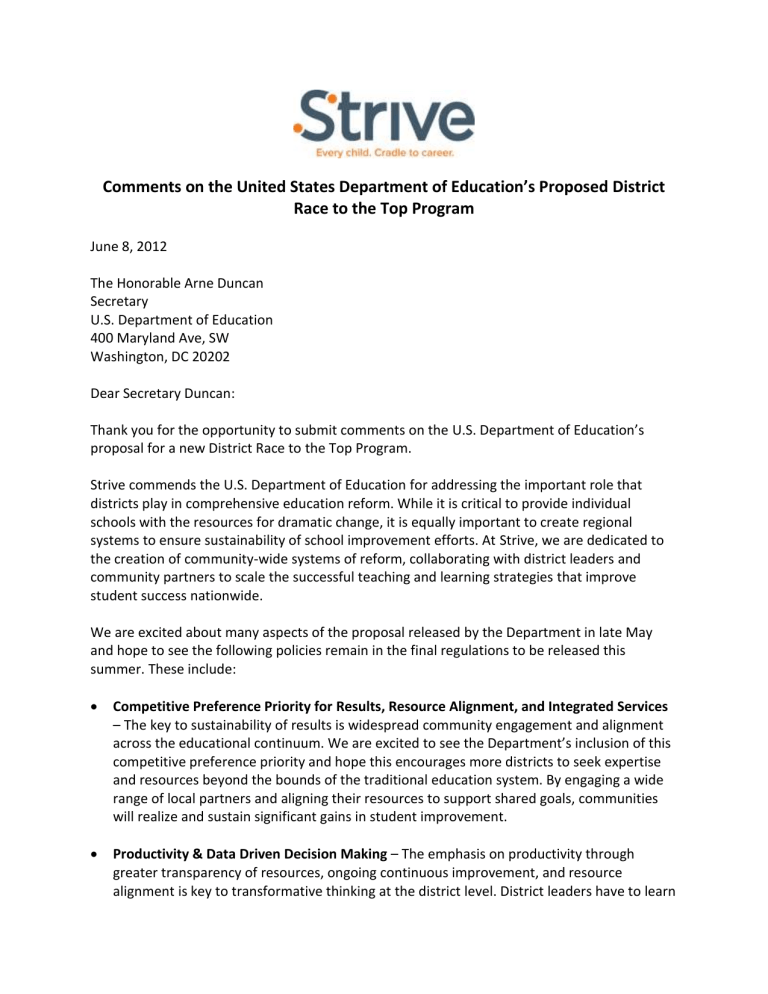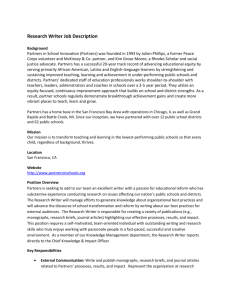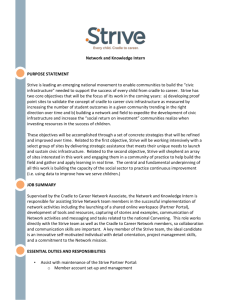here

Comments on the United States Department of Education’s Proposed District
Race to the Top Program
June 8, 2012
The Honorable Arne Duncan
Secretary
U.S. Department of Education
400 Maryland Ave, SW
Washington, DC 20202
Dear Secretary Duncan:
Thank you for the opportunity to submit comments on the U.S. Department of Education’s proposal for a new District Race to the Top Program.
Strive commends the U.S. Department of Education for addressing the important role that districts play in comprehensive education reform. While it is critical to provide individual schools with the resources for dramatic change, it is equally important to create regional systems to ensure sustainability of school improvement efforts. At Strive, we are dedicated to the creation of community-wide systems of reform, collaborating with district leaders and community partners to scale the successful teaching and learning strategies that improve student success nationwide.
We are excited about many aspects of the proposal released by the Department in late May and hope to see the following policies remain in the final regulations to be released this summer. These include:
Competitive Preference Priority for Results, Resource Alignment, and Integrated Services
– The key to sustainability of results is widespread community engagement and alignment across the educational continuum. We are excited to see the Department’s inclusion of this competitive preference priority and hope this encourages more districts to seek expertise and resources beyond the bounds of the traditional education system. By engaging a wide range of local partners and aligning their resources to support shared goals, communities will realize and sustain significant gains in student improvement.
Productivity & Data Driven Decision Making – The emphasis on productivity through greater transparency of resources, ongoing continuous improvement, and resource alignment is key to transformative thinking at the district level. District leaders have to learn
how to do more with less and new processes that emphasize continuous improvement and data driven decision making will empower districts to make important decisions about educational investments.
In addition to maintaining the policies above, Strive encourages the Department to consider the following improvements to the proposed District Race to the Top program:
Eligible Entity – Clarify that districts can partner with intermediary organizations to drive continuous improvement, identify impactful practices, and align and leverage local resources to scale practices that will help the district meet identified goals. These organizations can be critical partners in connecting siloed systems and services and engaging public and private funders seeking to reform education. Communities across the country have begun to partner with local intermediary organizations to identify what works and better organize community resources. The results are striking: improved student outcomes and significant social return on investment.
Ongoing Engagement of Community Stakeholders – While we commend the Department for encouraging applicants to engage community stakeholders in the application process, we encourage the Department to ensure continued involvement of key stakeholders throughout the implementation process. This will help Local Education Agencies (LEAs) expand their capacity and achieve sustainability of their reform goals. The Department can achieve this by adding the following language at the end of B.3.b. “and a description of the
roles that each stakeholder will play to help the LEA achieve its goals.”
Inclusion of Non-Academic Indicators – As districts track progress toward the goals outlined in their vision, it is important for districts to also track non-academic indicators. Success must be defined by academic performance and improvements to culture and the social and emotional well-being of students. We encourage the Department to add “at least two nonacademic indicators” to the list of areas LEAs must track under the section titled Vision. This will give districts the flexibility to identify indicators relevant to their student population.
Encourage Regional Scale and Sustainability – As applicants demonstrate how they will achieve district wide reform beyond participating schools, we believe it is important to encourage districts to think beyond their traditional geographic boundaries. The
Department should change the language in B.4.D. to read as follows:
How the implementation plan will translate into meaningful reform and support district wide change beyond participating schools, and help the LEA reach its improvement goals
(e.g., the applicant’s logic model or theory of change of how this approach will improve
Student outcomes across all schools in the LEA, community, and region.)
Additional Metrics for Performance Measurement – The following measures should be included in the performance measurement section to ensure a more robust picture of student learning:
Number and percentage of participating students reading on grade level
Number and percentage of participating students assessed ready for kindergarten
Number and percentage of participating students who enroll in and complete some form of postsecondary education and/or training
Drive Quality Continuous Improvement – To ensure grantees implement a quality continuous improvement process, we recommend strengthening the proposed language in
D.4. to read: “Strategy for implementing a rigorous continuous improvement process that provides timely and regular feedback on progress toward project goals and opportunities for ongoing corrections and improvements during and after the term of the grant. This must include how the applicant will monitor, measure and use data to improve and scale best
practices, and publicly share the quality of its Race to the Top District funded investments, such as professional development, technology, and staff.”
Elevate the Importance of Cradle to Career Partnerships and Alignment – Community collaboratives across the country have begun to move the needle on education reform, celebrating significant results that span from cradle to career. These collaboratives recognize the need for dramatic change across the entire education continuum and have committed to an ambitious vision that tracks success from kindergarten readiness to college and career success. The Department should encourage more communities to embrace this type of reform by applying a sliding scale to the competitive preference priority with maximum points awarded to districts seeking funds for a cradle to career approach.
Thank you for the opportunity to comment on this important proposal. We look forward to working with communities in the months ahead to support effective ideas that will better inform policy and practice.
Sincerely,
Jeff Edmondson
Managing Director
Strive Network
About Strive
Strive is catalyzing a national movement focused on the success of every child from cradle to career. Building on the principles of collective impact, Strive is helping communities create the civic infrastructure to unite stakeholders around shared goals, measures and results in education, and organizing a national network of cradle to career communities. Strive is a subsidiary of KnowledgeWorks.






